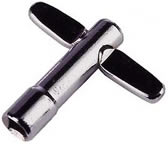 One of the most essential skills every drummer must know is how to tune their drumset. The reality is, most drummers do not know how to properly tune their kit; resulting in a poor sound. A drum kit can cost a lot of money, so why not make it sound the best it can! Let me try and uncover the mystery of
tuning your drums. It is actually not a very hard thing to do at all, so do not think you need to be a professional drummer before you can master this skill. Take the time in your regular practice to learn how to tune your drums the right way; you will be happy you did. If you have tuned your drum set as much as you can and you are still getting a poor sound, you may want to check out the article on
drum set muffling; here you will learn of other ways to maximize the sound of your drum set.
One of the most essential skills every drummer must know is how to tune their drumset. The reality is, most drummers do not know how to properly tune their kit; resulting in a poor sound. A drum kit can cost a lot of money, so why not make it sound the best it can! Let me try and uncover the mystery of
tuning your drums. It is actually not a very hard thing to do at all, so do not think you need to be a professional drummer before you can master this skill. Take the time in your regular practice to learn how to tune your drums the right way; you will be happy you did. If you have tuned your drum set as much as you can and you are still getting a poor sound, you may want to check out the article on
drum set muffling; here you will learn of other ways to maximize the sound of your drum set.
The first thing you need to realize about drum tuning is that it is a very personal thing. Having the right drum sound is completely up to what you are looking for. Depending on what style of music you play, you could want your drums tuned to many different tones. Now that being said, there are a few rules that you must consider when tuning. There are a few steps you must take in order to maximize your tone, resonance and endurance of your drum head. So let’s get started.
Tuning one drum is the same as tuning them all. The same steps and procedures should be taken to ensure the best sound from any drum you are playing. Let’s say we are tuning a tom drum. Let’s start at the absolute beginning; seating the drum head on the shell. Before you even place the head on the drum, make sure you wipe down both the rim and the head. Any unwanted dirt or chips will cause an uneven sound on the tom. So with a towel, just wipe around the rim of the drum. The next step is obviously seating the drum head on the drum. Once this is done, and the rim is placed over top; screw in the tension rods hand tight. You do not want to screw them in to much right now, or you can throw off the tuning process. This step is just for positioning the rods.
---------------------------------------------------------------------------------------------------
The
Drumming System now includes a DVD on Drum Setup, Tuning, & Gear Tips - so you can make your snare drum, bass drum, and toms sound their absolute best.
See more.
---------------------------------------------------------------------------------------------------
Once all the rods are secure, you want to stretch out your drum head. This is an important step to do; it will strengthen and stretch out your skin as well as help it maintain its tuning once it is found. To do this, simply make a fist, and press down in the middle of the drum. Do not press to hard, you do not want to damage your skin. This is the same idea as a guitarist stretching out his new strings before he tunes. Now you are finally ready to tune!
This process is similar to installing a new tire on your car. To make sure there is no unbalance, you will have to tighten the tension rods opposite to each other. The best way to do this is to start at any rod, and tighten a few turns with your drum key. Once that is complete, locate the tension rod opposite to that one and repeat the process. Do this until each rod is secure and tight. Try to keep each turn uniform by counting the amount of rotations and imitate that on each tension rod. Here is a diagram of the tightening process:

As you can see, each tension rod is tuned opposite of each other. Start at A, and work your way around the drum.
Once each rod is tightened, try striking the drum. Chances are you will not get the right sound on your first try. This is where you have to start fine tuning. Pick a tension rod to start at, and tap the head around 2 inches from that rod. Again, use the diagram and tap each rod opposite to each other. Try and hear for any inconsistent sounds. If there are any tones that are not even, tune each tension rod accordingly. Remember this is a fine process, tuning a half a turn will change the sound to the whole drum.
Like I said above, each drummer has his/her own preference with sound depending on what style of music they are playing. Whatever the sound you are going for, follow these simple steps. Remember that tuning your drums can be a long process; being patient and diligent will reward you in the end. Do not worry if you cannot get a solid sound out of your drum, a lot of times the room your drums are in can have a huge impact on the sound of the drums. Once you have the best sound you can get from your drums, it's time to start learning some new beats and grooves! Check out the beginners section to learn how to play the drums. When you have this down, you can start learning some other concepts like the double bass drum, and drum rudiments!
The Drum Tuning System will show you exactly how to tune your drums to sound great in any playing situation.
If you want to learn drum tuning as well as get more lessons on how to play drums, the Drumming System is the complete solution. There's a full DVD on Drum Setup, Tuning, & Gear Tips - as well as drum lessons on hand technique, drum beats, drum fills, drum rudiments, bass drum technique, soloing, and much more. Click here for more details.


Enter your email to get sheet music for 100 of drumming’s biggest songs FREE.